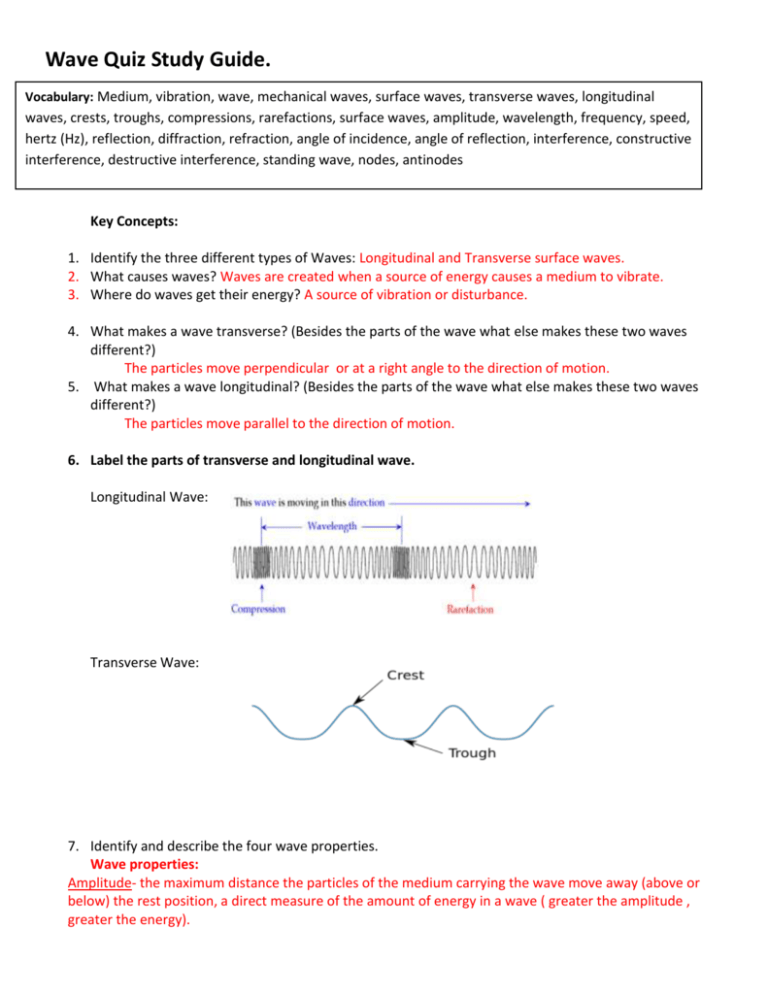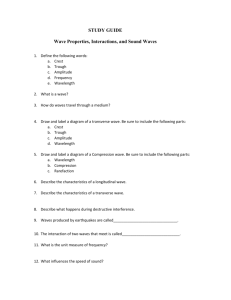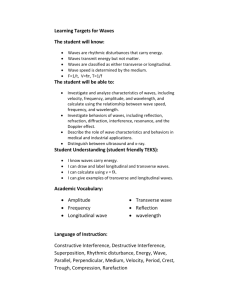Wave Quiz Answer key
advertisement

Wave Quiz Study Guide. Vocabulary: Medium, vibration, wave, mechanical waves, surface waves, transverse waves, longitudinal waves, crests, troughs, compressions, rarefactions, surface waves, amplitude, wavelength, frequency, speed, hertz (Hz), reflection, diffraction, refraction, angle of incidence, angle of reflection, interference, constructive interference, destructive interference, standing wave, nodes, antinodes Key Concepts: 1. Identify the three different types of Waves: Longitudinal and Transverse surface waves. 2. What causes waves? Waves are created when a source of energy causes a medium to vibrate. 3. Where do waves get their energy? A source of vibration or disturbance. 4. What makes a wave transverse? (Besides the parts of the wave what else makes these two waves different?) The particles move perpendicular or at a right angle to the direction of motion. 5. What makes a wave longitudinal? (Besides the parts of the wave what else makes these two waves different?) The particles move parallel to the direction of motion. 6. Label the parts of transverse and longitudinal wave. Longitudinal Wave: Transverse Wave: 7. Identify and describe the four wave properties. Wave properties: Amplitude- the maximum distance the particles of the medium carrying the wave move away (above or below) the rest position, a direct measure of the amount of energy in a wave ( greater the amplitude , greater the energy). Wavelength- the distance between two corresponding ( matching) parts of the wave. Frequency- the number of complete waves that pass a given point in a certain amount of time. The more waves that pass the higher the frequency. Speed- how far a wave travels in a unit of time, or distance divided by time. 8) Can two Waves have the same wavelength but different amplitudes? Explain. A) How are wavelength and amplitude measured in longitudinal and transverse waves? Transverse Wave : Wavelength- measure distance from crest to crest Amplitude - Measure distance from rest to crest or rest. Longitudinal Wave: Wavelength- measure the distance from compression to compression. Amplitude- measure how crowded the compressions are, closer together means a greater amplitude, farther apart means less amplitude. A. Which of the waves below has a high frequency? a low frequency? How can you tell? B) Why can waves with a the same speed have different frequencies? Because of the wavelength. Waves with shorter wavelength have higher frequencies because they are closer together, so more waves can pass a certain point more often, waves with longer wavelengths have lower frequencies. 9. What type of wave interaction is this? How do you know? Refraction because the wave is bending when it changes mediums. This happens when the waves enters new medium at an angle causing the wave to change speed and bend. 10.What type of wave interaction is this? How do you know? Reflection. The wave can not go through or around the mirror so it bounces off the mirror. The incoming wave (angle of incidence) is equal the outgoing wave ( angle of reflection). 11. Draw arrows to show what direction the wave will travel after is passes through the hole in the barrier. What type of wave interaction is this? How do you know? Direction of wave The wave will spread out once it passes through the barrier. This is diffraction because diffraction is when a wave bends or spreads out after it passes a barrier or moves through a hole in a barrier. 12. What does it mean when waves interfere? What is the difference between constructive and destructive interference. Interference in when two waves meet and have an effect on each other. Constructive interference is when the two waves meet and the crests of the waves align and the amplitudes combine to form a wave with a larger amplitude. Destructive interference is when the trough and crest of the wave align and combine to produce a wave with less or smaller amplitude. 13. What causes standing wave? What are its parts? Draw and label a diagram of a standing wave. A standing wave is a wave that appears to stand in one place even though it is really two waves interfering when their parts pass through each other. When vibrations create a transverse wave that reflects back the crest and troughs align causing areas of constructive and destructive interference. The part of a standing wave that includes the crest and troughs is called the antinode. The part where the wave does not move and has a amplitude of zero is called the node. Node Antinode








